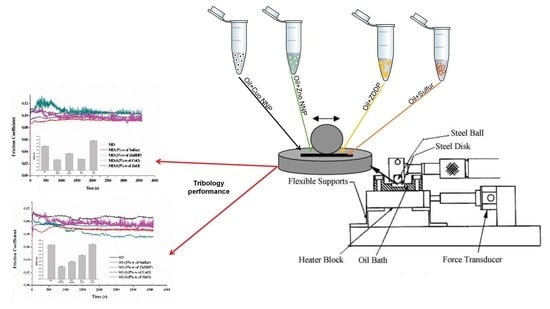Comparison Between the Action of Nano-Oxides and Conventional EP Additives in Boundary Lubrication
Abstract
1. Introduction
2. Methodology
2.1. Preparation Lubricants
2.2. Tribological Assessment
3. Results and Discussion
3.1. Chemical Composition, Shape, and Size of Nanoparticles
3.2. Tribological Assessment of HFRR
3.3. Morphological and Chemical Surfaces Analyses
4. Conclusions
- The additives EP (ZDDP) in the contact between surfaces (metal-metal) presented good performance as anti-wear in both lubricant bases.
- The sulfur additive served to decrease friction, as a low friction additive, but did not have useful anti-wear characteristics.
- For the zinc oxides nanoparticles, the formation of a protective film can be observed by adhesion on the surface. The SEM images showed a homogeneous surface comparable between the other additives. Its performance was similar to ZDDP, as the protective film was formed and served as a good anti-wear and low friction additive, more effective for a mineral lubricant base.
- The CuO nanoparticles in the synthetic lubricant base obtained better results in reducing the coefficient of friction between all other results and suggest that it is a great low friction additive.
- The oxide nanoparticles function differently in base oils. Depending on the oil, these additives improve or worsen the lubricant performance.
Author Contributions
Funding
Conflicts of Interest
References
- Chinas-Castillo, F.; Ha, S. Behavior of colloidal solid particles in elastohydrodynamic contacts. J. Tribol. Trans. 2000, 43, 387–394. [Google Scholar] [CrossRef]
- Dowson, D. History of Tribology; Professional Engineering Publishing Ltd.: London, UK, 1998. [Google Scholar]
- Alves, S.M.; Barros, B.S.; Trajano, M.F.; Ribeiro, K.S.B.; Moura, E. Tribological behavior of vegetable oil-based lubricants with nanoparticles of oxides in boundary lubrication conditions. Tribol. Int. 2013, 65, 28–36. [Google Scholar] [CrossRef]
- Taylor, L.; Dratva, A.; Spikes, H.A. Friction and wear behavior of zinc dialkyldithiophosphate additive. Tribol. Trans. 2000, 43, 469–479. [Google Scholar] [CrossRef]
- Bell, J.C.; Delargy, K.M.; Seeney, A.M. Paper IX (ii) the removal of substrate material through thick zinc dithiophosphate anti-wear films. Tribol. Ser. 1992, 21, 387–396. [Google Scholar]
- Spikes, H. The history and mechanisms of ZDDP. Tribol. Lett. 2004, 17, 469–489. [Google Scholar] [CrossRef]
- Taylor, L.J.; Spikes, H.A. Friction-enhancingproperties of ZDDP antiwear additive: Part I—Friction andmorphology of ZDDP reactionfilms. Tribol. Trans. 2003, 46, 303–309. [Google Scholar] [CrossRef]
- Kumar, G.; Garg, H.C.; Gijawara, A. Experimental investigation of tribological effect on vegetable oil with CuO nanoparticles and ZDDP additives. Ind. Lubr. Tribol. 2019, 71, 1–10. [Google Scholar] [CrossRef]
- Martins, I.S. Study of Characteristics of Extreme Pressure and Wear Oils Additives, Tested in Four Ball Machine. Master’s Thesis, Faculdade de Engenharia da Universidade do Porto, Porto, Portugal, 1995. [Google Scholar]
- Spike, H. Low- and zero-sulphated ash, phosphorus and sulphur anti-wear additives for engine oils. Lubr. Sci. 2008, 20, 103–136. [Google Scholar] [CrossRef]
- Johansson, J.E.; Devlin, M.T.; Prakash, B. Lubricant additives for improved pitting performance through a reduction of thin-film friction. Tribol. Int. 2014, 80, 122–130. [Google Scholar] [CrossRef]
- Alves, S.M.; Mello, V.S.; Faria, E.A.; Camargo, A.P.P. Nanolubricants developed from tiny CuO nanoparticles. Tribol. Int. 2016, 100, 263–271. [Google Scholar] [CrossRef]
- Hu, Z.S.; Dong, J.X.; Chen, G.X.; He, J.Z. Preparation and tribological properties of nanoparticle lanthanum borate. Wear 2000, 243, 43–47. [Google Scholar] [CrossRef]
- Alves, S.M.; Mello, V.S.; Sinatora, A. Nanolubrication Mechanisms: Influence of Size and Concentration of CuO Nanoparticles. Mater. Perform. Charact. 2018, 7, 226–241. [Google Scholar] [CrossRef]
- Bhaumiket, S.; Maggirwar, R.; Datta, S.; Pathak, S.D. Analyses of anti-wear and extreme pressure properties of castor oil with zinc oxide nano friction modifiers. Appl. Surf. Sci. 2018, 449, 277–286. [Google Scholar] [CrossRef]
- Battez, A.H.; Gonzalez, R.; Viesca, J.L.; Fernandez, J.E.; Fernández, J.M.D.; Machado, A.; Chou, R.; Riba, J. CuO, ZrO2 and ZnO nanoparticles as antiwear additive in oil lubricants. Wear 2008, 265, 422–428. [Google Scholar] [CrossRef]
- Padgurkas, J.; Rukuiza, R.; Prosycevas, I.; Kreivaitis, R. Tribological properties of lubricant additives of Fe, CuO and Co nanoparticles. Tribol. Int. 2013, 60, 224–232. [Google Scholar] [CrossRef]
- Liu, G.; Li, X.; Qin, B.; Xing, D.; Guo, Y.; Fran, R. Investigation of the Mending Effect and Mechanism od Copper nano-particles on the Tribologically Stressed Surface. Tribol. Lett. 2004, 17, 961–966. [Google Scholar] [CrossRef]
- Peng, D.X.; Kang, Y.; Hwang, R.M.; Shyr, S.S.; Chang, Y.P. Tribological properties of diamond and SiO2 nanoparticles added to paraffin. Tribol. Int. 2009, 42, 911–917. [Google Scholar] [CrossRef]
- Mello, V.S.; Faria, E.A.; Alves, S.M.; Scandian, C. Enhancing Cuo nanolubricant performance using dispersing agents. Tribol. Int. 2020, 150, 106338. [Google Scholar] [CrossRef]
- Trajano, M.F.; Moura, E.I.F.; Ribeiro, K.S.B.; Alves, S.M. Study of oxide nanoparticles as additives for vegetable lubricants. Mater. Res. 2014, 17, 1124–1128. [Google Scholar] [CrossRef]
- Chen, Y.; Liang, H.; Renner, P. Dispersion of Nanoparticles in Lubricating Oil: A Critical Review. Lubricants 2019, 7, 7. [Google Scholar] [CrossRef]
- Peña-Parás, L.; Taha-Tijerina, J.; Garza, L.; Maldonado-Corte’s, D.; Michalczewski, R.; Lapray, C. Effect of CuO and Al2O3 nanoparticle additives on the tribological behaviorof fully formulated oils. Wear 2015, 332–333, 1256–1261. [Google Scholar] [CrossRef]
- Peña-Parás, L.; García-Pineda, P.; Maldonado-Cortés, D.; Garza, G.T.; Taha-Tijerina, J. Temperature dependence of the extreme-pressure behavior of CuO and TiO2 nanoparticle additives in metal-forming polymeric lubricants. Ind. Lubr. Tribol. 2017, 69, 730–737. [Google Scholar] [CrossRef]
- Wu, Y.Y.; Tsui, W.C.; Liu, T.C. Experimental analysis of tribological properties of lubricating oils with nanoparticle additives. Wear 2007, 262, 819–825. [Google Scholar] [CrossRef]
- Strayer, M.E.; Binz, J.M.; Tanase, M.; Mehdi, S.; Shahri, K.; Sharma, R.; Rioux, R.M.; Mallouk, T.E. Interfacial bonding stabilizes rhodium and rhodium oxide nanoparticles on layered Nb oxide and Ta oxide supports. J. Am. Chem. Soc. 2014, 136, 5687–5696. [Google Scholar] [CrossRef] [PubMed]
- Aldana, P.U.; Vacher, B.; Le-Mogne, T.; Belin, M.; Thiebaut, B.; Dassenoy, F. Action Mechanism of WS2 Nanoparticles with ZDDP Additive in Boundary Lubrication Regime. Tribol. Lett. 2014, 56, 249–258. [Google Scholar] [CrossRef]
- Martin, J.M.; Onodera Bouchet, M.I.B.; Hatakeyama, N.; Miyamoto, A. Anti-wear Chemistry of ZDDP and Calcium Borate Nano-additive. Coupling Experiments, Chemical Hardness Predictions, and MD Calculations. Tribol. Lett. 2013, 50, 95–104. [Google Scholar] [CrossRef]
- Zhou, J.; Wu, Z.; Zhang, Z.; Liu, W.; Dang, H. Study on an antiwear and extreme pressure additive of surface coated LaF3 nanoparticles in liquid paraffin. Wear 2001, 249, 333–337, PII: S0043-1648(00)00547-0. [Google Scholar] [CrossRef]
- Van Der Venn, I.; De Boer, J. Phosphorus flame retardants: Properties, production, environmental occurrence, toxicity and analysis. Chemosphere 2012, 88, 1119–1153. [Google Scholar] [CrossRef]
- Guo, D.; Xie, G.; Luo, J. Mechanical properties of nanoparticles: Basics and applications. J. Phys. D Appl. Phys. 2014, 47, 013001. [Google Scholar] [CrossRef]
- Gulzar, M.; Masjuki, H.H.; Kalam, M.A.; Varman, M.; Zulkifli, N.W.M.; Mufti, R.A.; Zahid, R. Tribological performance of nanoparticles as lubricating oil additives. J. Nanoparticle Res. 2016, 18, 223. [Google Scholar] [CrossRef]
- Asadauskas, S.J.; Biresaw, G.; McClure, T.G. Effects of Chlorinated Paraffin and ZDDP Concentrations on Boundary Lubrication Properties of Mineral and Soybean Oils. Tribol. Lett. 2009, 37, 111–121. [Google Scholar] [CrossRef]
- Farhanah, A.N.; Syahrullail, S. Tribological Behaviour of Zinc DialkylDithiophosphate (ZDDP) as a Lubricant Additive in RBD Palm Stearin. J. Adv. Res. Fluid Mech. Ther. Sci. 2015, 11, 19–26, ISSN: 2289-7879. [Google Scholar]
- Alias, M.A.M.; Abdollah, B.; Tokoroyama, T.; Umehara, N. Effect of zinc dioctyl dithophospate concentrations on the friction coefficient of palm oil. In Proceedings of the SAKURA Symposium on Mechanical Science and Engineering, Nagoya University, Nagoya, Japan, 12 September 2017; pp. 20–21. [Google Scholar]
- Beran, E. Effect of chemical structure on the hydrolytic stability of lubricating base oils. Tribol. Int. 2010, 43, 2372–2377. [Google Scholar] [CrossRef]
- Lin, Y.C.; So, H. Limitations on use of ZDDP as an antiwear additive in boundary lubrication. Tribol. Int. 2004, 37, 25–33. [Google Scholar] [CrossRef]
- Stachowiak, G.; Batchelor, A. Engineering Tribology, 4th ed.; Chapter 8—Boundary and Extreme Pressure Lubrication; Elsevier: Amsterdam, The Netherlands, 2014; pp. 371–428. [Google Scholar]
- Li, J.; Ma, H.; Ren, T.; Zhao, Y.; Zheng, L.; Ma, C.; Han, Y. The tribological chemistry of polysulfides in mineral oil and synthetic diester. Appl. Surf. Sci. 2008, 254, 7232–7236. [Google Scholar] [CrossRef]
- Jamil, Y.; Ahmad, M.; Hafeez, A.; Haq, Z.-U.; Amin, N. Microwave assisted synthesis of fine magnetic manganese ferrite particles using co-precipitation technique. Pak. J. Agric. Sci. 2008, 45, 59–64. [Google Scholar]
- Olejniczak, A.; Chostenko, A.G.; Fall, J. Discrimination of base oils and semi-products using principal component analysis and self organizing maps. Fuel 2010, 89, 1150–1155. [Google Scholar] [CrossRef]
- Mello, V.S.; Souza, E.R.V.; Oliveira, M.V.A.; Alves, S.M. Effect of desulfurization of diesel and its blends with biodiesel on metallic contact. Mater. Res. 2014, 17 (Suppl. 1), 82–88. [Google Scholar] [CrossRef][Green Version]
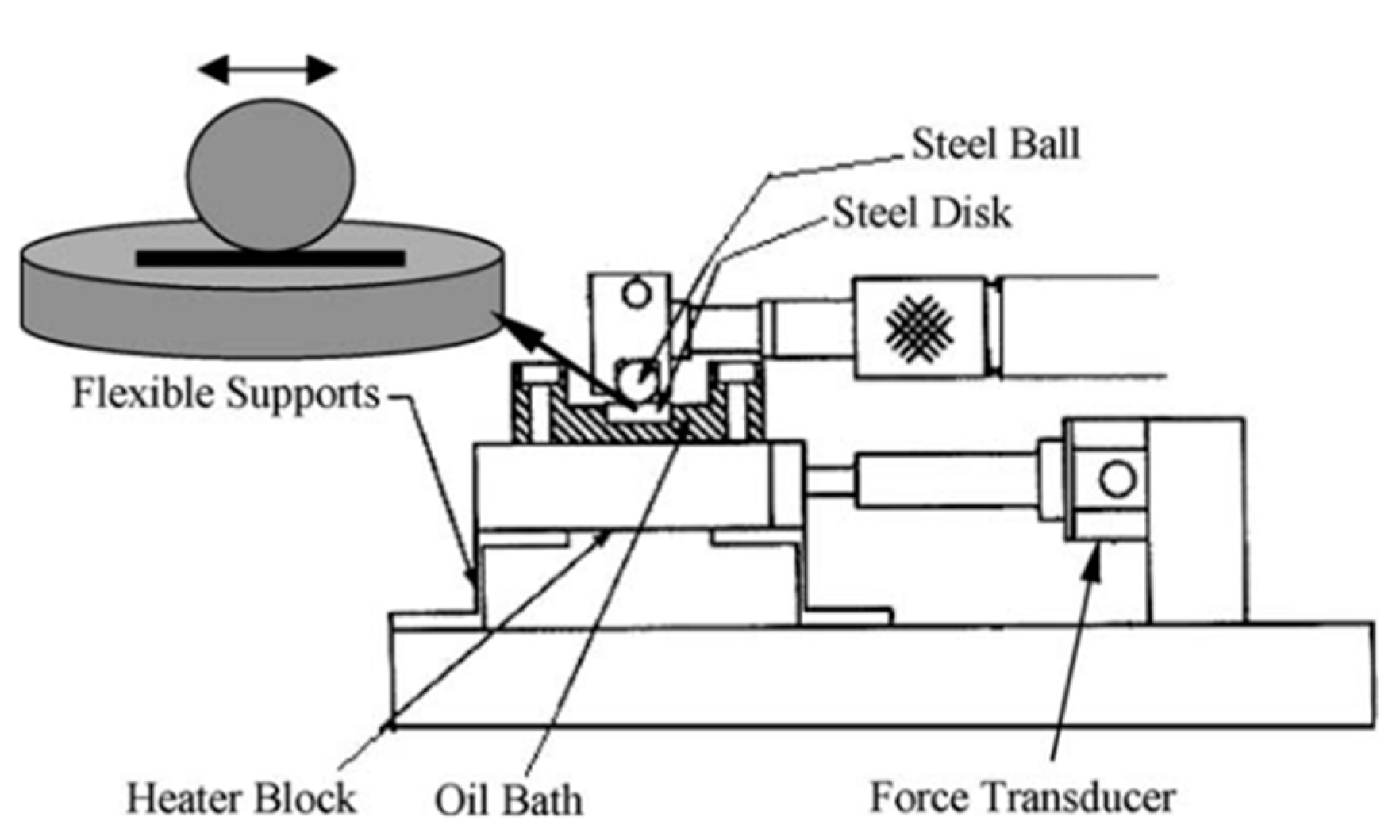
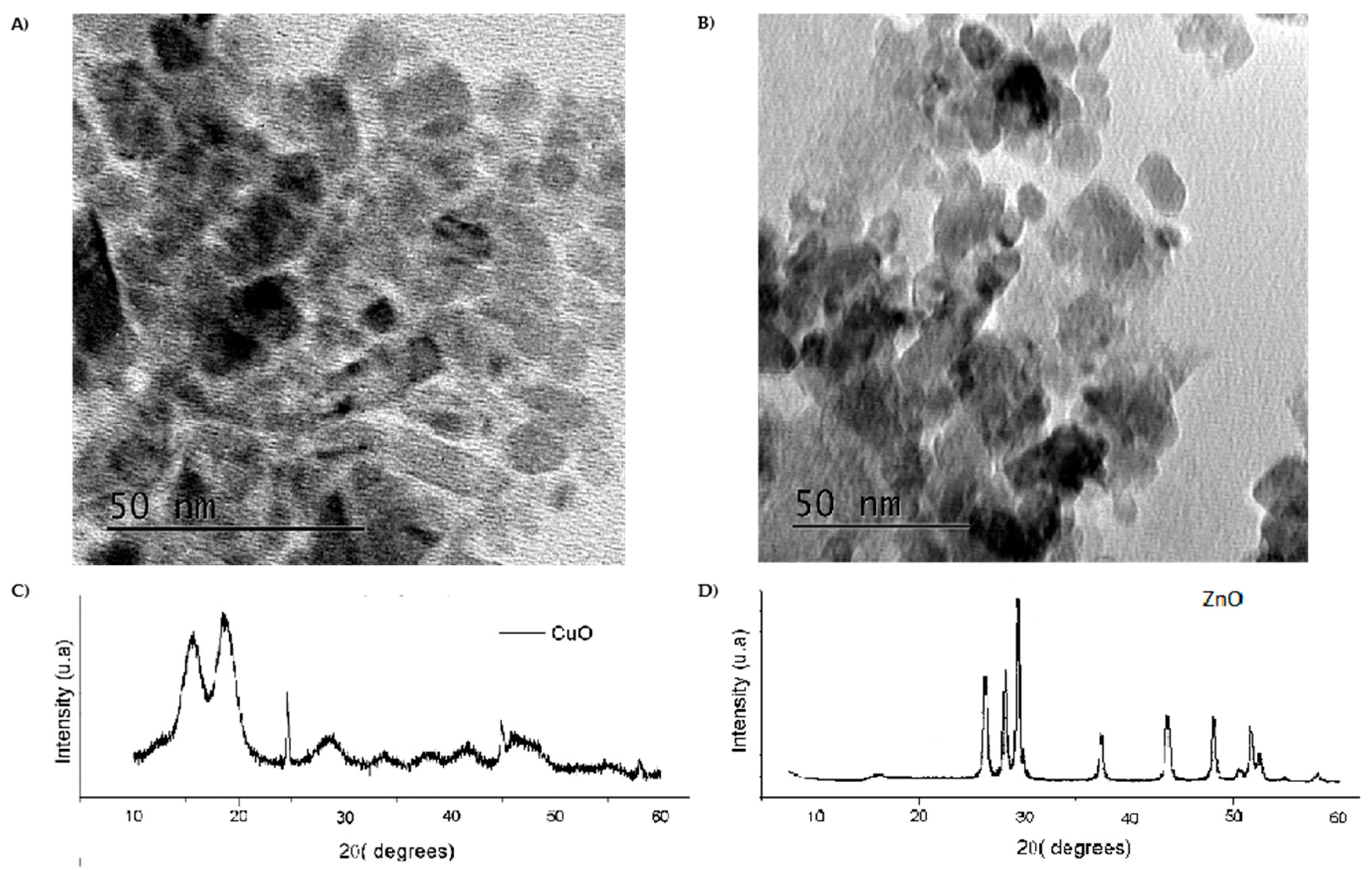


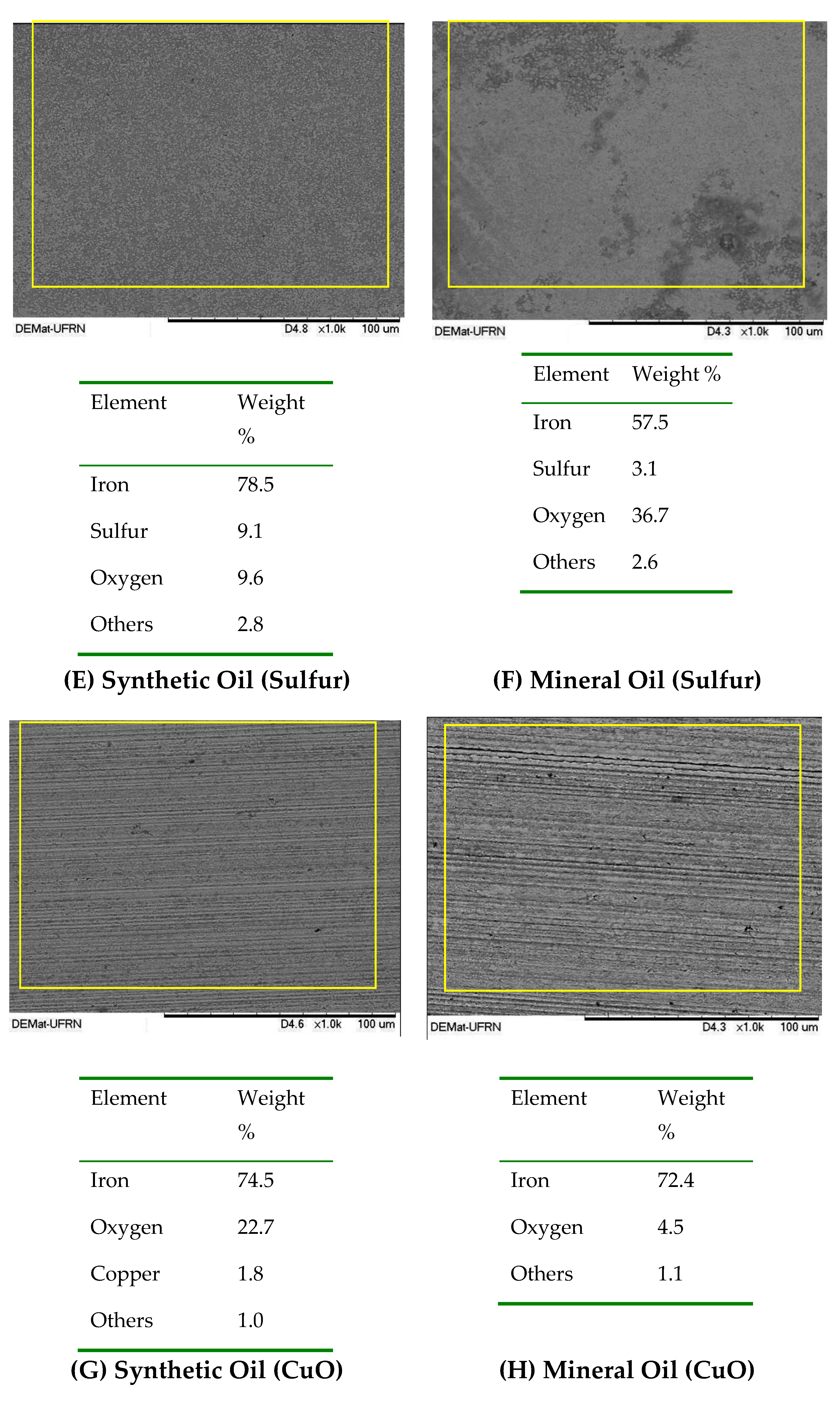
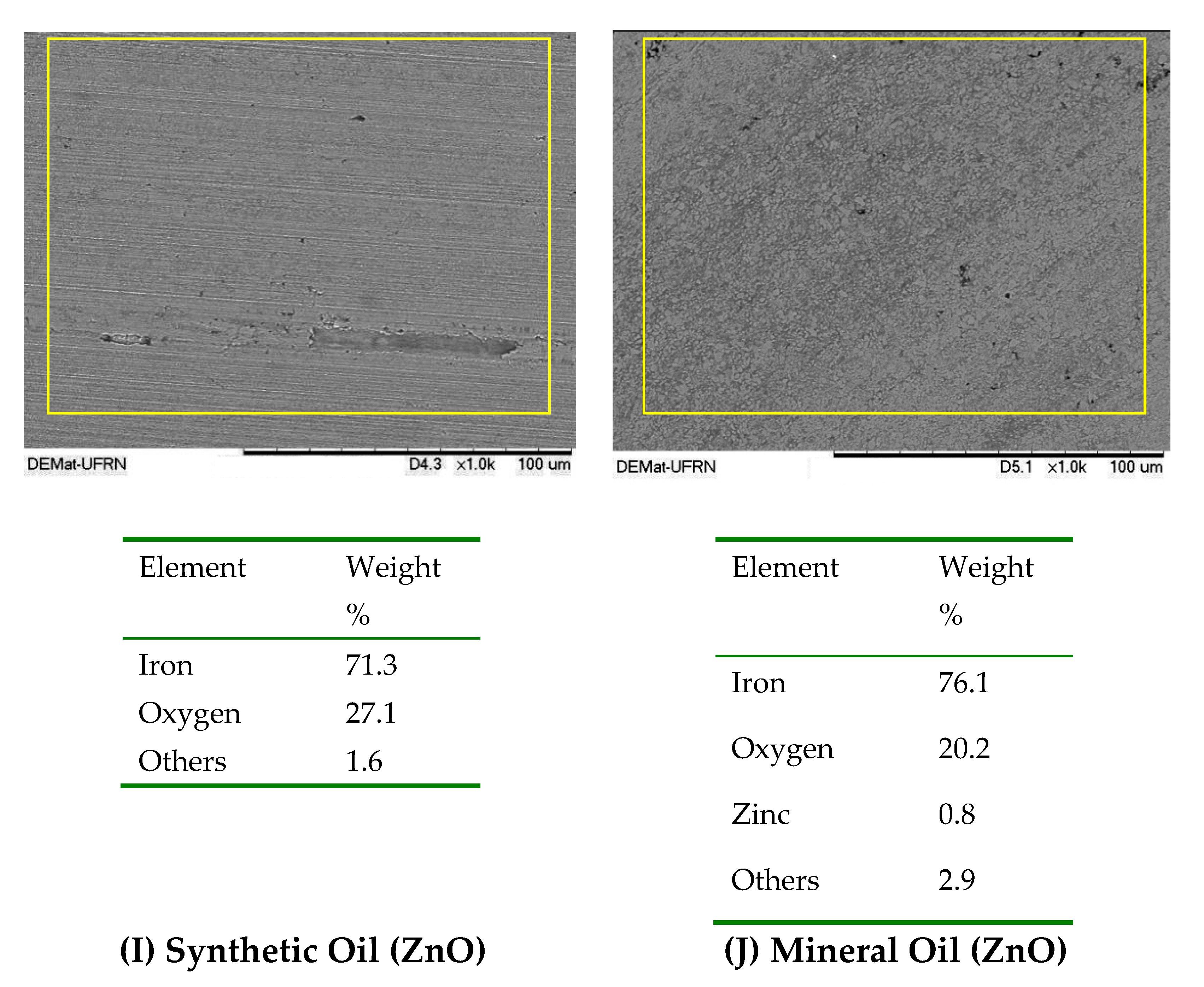
| Additives |
|---|
| Zinc dialkyl dithiophosphate (ZDDP)—it has in its composition 3.5% of sulfur, 1.9% of phosphorus, and 2.1% of zinc. |
| EP sulfur-phosphorus additive (chemical states—sulfide (S−2)) —sulfur active in high temperature |
| Oil/ Parameters | Density (g/cm3) | Viscosity (40–100 °C) | Flash Point (°C) | Viscosity Index |
|---|---|---|---|---|
| Mineral (Parafinic) | 0.8474 | 52.55/7.64 | 176 | 108 |
| Synthetic (PAO 40) | 0.8303 | 51.84/8.87 | 170 | 150 |
| Parameters | Ball (AISI 52100 Stell) | Disk (AISI 52100 Stell) |
|---|---|---|
| Hardness (HV) | (570–750) | (190–210) |
| Dimensions | Diameter = 6.0 mm | Diameter = 10.0 mm Thickness = 3.0 mm |
| Roughness – Sa (µm) | 0.04 | 0.02 |
| Oils with Additives | Average Friction Coefficient | WSD (µm) | |||
|---|---|---|---|---|---|
| SO pure | MO pure | 0.106 ± 0.003 | 0.104 ± 0.003 | 274 | 266 |
| SO + ZDDP | MO + ZDDP | 0.094 ± 0.002 | 0.097 ± 0.003 | 243 | 246 |
| SO + Sulfur | MO + Sulfur | 0.087 ± 0.003 | 0.092 ± 0.002 | 250 | 255 |
| SO + ZnO | MO + ZnO | 0.097 ± 0.005 | 0.099 ± 0.006 | 259 | 247 |
| SO + CuO | MO + CuO | 0.080 ± 0.008 | 0.108 ± 0.007 | 275 | 274 |
© 2020 by the authors. Licensee MDPI, Basel, Switzerland. This article is an open access article distributed under the terms and conditions of the Creative Commons Attribution (CC BY) license (http://creativecommons.org/licenses/by/4.0/).
Share and Cite
Mello, V.S.; Trajano, M.F.; Guedes, A.E.D.S.; Alves, S.M. Comparison Between the Action of Nano-Oxides and Conventional EP Additives in Boundary Lubrication. Lubricants 2020, 8, 54. https://doi.org/10.3390/lubricants8050054
Mello VS, Trajano MF, Guedes AEDS, Alves SM. Comparison Between the Action of Nano-Oxides and Conventional EP Additives in Boundary Lubrication. Lubricants. 2020; 8(5):54. https://doi.org/10.3390/lubricants8050054
Chicago/Turabian StyleMello, Valdicleide Silva, Marinalva Ferreira Trajano, Ana Emilia Diniz Silva Guedes, and Salete Martins Alves. 2020. "Comparison Between the Action of Nano-Oxides and Conventional EP Additives in Boundary Lubrication" Lubricants 8, no. 5: 54. https://doi.org/10.3390/lubricants8050054
APA StyleMello, V. S., Trajano, M. F., Guedes, A. E. D. S., & Alves, S. M. (2020). Comparison Between the Action of Nano-Oxides and Conventional EP Additives in Boundary Lubrication. Lubricants, 8(5), 54. https://doi.org/10.3390/lubricants8050054



